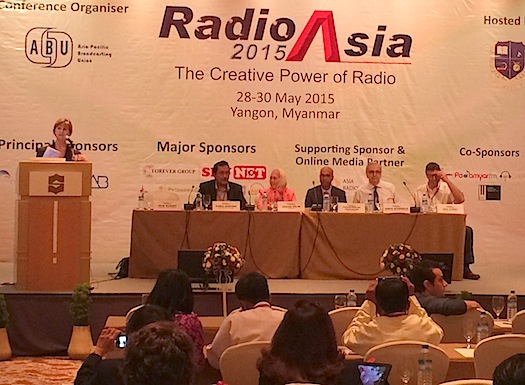During a RadioAsia 2015 conference session titled Implementation of digital radio in Asia-Pacific, Commercial Radio Australia CEO Joan Warner shared the story of digital radio in Australia, and how radio companies cannot solely rely on telecommunication companies to provide reliable streaming services.
“Radio should not be forced to think that our only digital option is to use an unreliable mobile network. Mobile networks cannot provide free to air alternatives to radio,” said Warner speaking to local and international delegates at the 3 day conference.
Digital radio in Australia began in 2009, and in the first year listeners only purchased 100,000 digital receivers. With an industry led marketing campaign, and cheaper receivers now being available, recent figures show that there are now 3 million receivers in Australia.
“Australia chose DAB+ because there were hundreds of receivers on the market, and it makes the best use of the spectrum. Australia now has 3 times as many stations in major cities”, continued Warner.
The Asia-Pacific region is incredibly important to the future of digital radio, with a number of countries investigating digital trials. One of the countries planning to trial digital radio in 2016 is Thailand.
Supinya Klangnarong is the Commissioner of the National Broadcasting and Telecommunications Commission (NBTC) in Thailand, and shared how important digital radio will be in the country.
“Thailands FM spectrum is fully optimized…with over 10,000 FM stations on-air before the military coup last year”, said Klangnarong. Following the military coup, 6000 stations were shutdown. 4000 are back on-air, with 2000 waiting on the go ahead from the government.
Thailand is trialing digital radio as a possible way to fix the crowded spectrum, but is concerned about the economic and political. Thailand has a large population, with the majority living in rural areas and on low incomes. One of the concerns for the NBTC is the price of receivers.
“Yes, we are concerned about the price of receivers and we have to make the people can afford to buy them”, said Klangnarong.
One of the possible alternatives for countries like Thailand to reach their vast rural population is to look at DRM (Digital Radio Mondiale) technology. Peter Streader is the Regional Manager for Ampegon, a company that provides solutions through its DRM technology.
DRM works in the AM spectrum, and also up to FM frequencies. It provides more choice for listeners, excellent audio quality, very good coverage and automatic tuning. DRM is a possible solution for countries with large rural populations.
“India has chosen to use DRM to cover their regional areas, using DRM30 mostly, which operates in the medium wave band…DRM can deliver the features to large or remote areas at low cost,” Streader told the conference.
The future of radio is definitely digital. Australia is in discussion with car manufacturers, which will see DAB+ in 26 auto brands. There is also the “Universal Phone Project”, which will involve DAB+ broadcast chips being installed in mobile phones.
Digital radio provides better quality, more content options, more stations, and will continue to be provided for free in the future. So there is no need to worry about blowing your monthly data allowance on streaming your favourite station.

